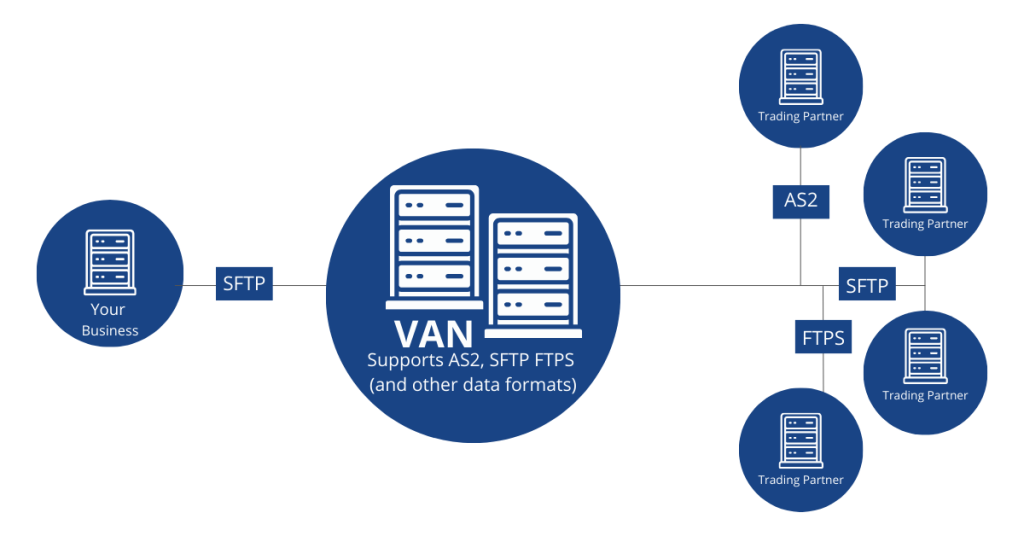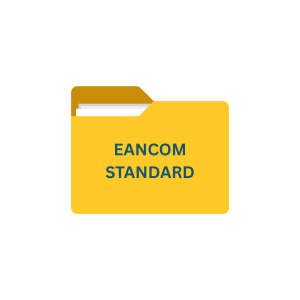Introduction to VAN and MFT
Secure and reliable data transfer is crucial for businesses of all sizes. Value-Added Networks (VANs) and Managed File Transfer (MFT) solutions are two popular technologies for managing these transfers. While both facilitate secure data exchanges, VANs stand out in certain areas, particularly for industries where Electronic Data Interchange (EDI) is critical to operations. Compared to an MFT solution, a VAN offers a more cost-effective option, eliminating the need for expensive hardware and software updates. Additionally, VANs provide a user-friendly interface, making it easy for both technical and non-technical users to navigate.
In contrast, an MFT solution is a software-based platform that manages the file transfer process within an organization or between business partners. MFT solutions often incorporate features like encryption, automated workflows, and comprehensive reporting, but they are primarily designed to handle the file transfer aspect of communication, rather than the broader ecosystem of data exchange. In this blog, we’ll explain why using a VAN can offer more value to businesses than opting for an MFT solution, focusing on security, compliance, reliability, and industry-specific benefits
Key Takeaways
- VAN vs MFT: Value-Added Networks (VAN) and Managed File Transfer (MFT) solutions are both used for securely exchanging data, but VANs offer additional benefits over MFT for businesses with complex B2B communications.
- Security & Compliance: VANs provide built-in security protocols, encryption, and compliance with industry regulations, making them a better choice for industries with strict compliance needs.
- Network Reach: VANs connect businesses to a broad network of trading partners, allowing for seamless integration and data exchange without the need to manage multiple individual connections.
- Simplified Management: VANs offer centralized management of all EDI transactions, making it easier for companies to monitor, track, and troubleshoot data flows.
- Cost Efficiency: By using a VAN, businesses avoid the costs of building and maintaining their own infrastructure for secure data transfer, as well as the complexities of managing multiple MFT connections.
- Scalability: VANs provide scalable solutions that can adapt to growing data exchange needs, offering flexibility as the business expands its partnerships and communication requirements.
- Data Archiving & Support: VANs often come with additional features such as data archiving, reporting, and customer support, which enhance the overall experience of managing EDI transactions.
Defining VAN and MFT
What is a VAN (Value-Added Network)?
A Value-Added Network (VAN) is a private, third-party network that securely facilitates the exchange of EDI documents between trading partners. VANs act as intermediaries, offering data transmission and additional services such as data translation, compliance monitoring, and error correction. VANs are often used in industries that require a high degree of security and regulatory compliance, such as retail, healthcare, and logistics.
What is MFT (Managed File Transfer)?
Managed File Transfer (MFT) is a software solution designed to secure and control the exchange of files between systems, businesses, and individuals. MFT supports various file types and communication protocols, such as FTP, SFTP, and AS2, providing encryption, automation, and monitoring capabilities. MFT solutions are used across multiple industries for transferring data securely, but they are often general-purpose solutions, not tailored specifically for EDI.
Why VAN is Better Than MFT?

Although both VAN and MFT solutions are designed to securely transfer data, VAN offers several distinct advantages that make it the better choice for many businesses, especially those that rely heavily on EDI.
1. Tailored for EDI and Industry Standards
VANs are specifically designed for industries that use EDI for communication, making them far more efficient for businesses needing standardized document exchanges.
EDI Optimization: VANs specialize in transmitting standardized EDI formats such as ANSI X12 and EDIFACT, making them ideal for businesses in retail, healthcare, logistics, and manufacturing. They are equipped to handle complex document flows such as purchase orders, invoices, shipment notices, and more.
MFT Limitations: While MFT can handle EDI, it lacks the built-in optimization for handling these specific document types. MFT solutions are often more generalized and may require additional configuration and tools to handle EDI correctly, making them less efficient for businesses with high EDI traffic.
2. Enhanced Security and Compliance
VANs are built with compliance in mind, which is critical for industries that need to adhere to strict regulatory requirements.
Compliance Ready: VANs meet industry-specific standards such as PCI DSS for financial services, and GDPR for data protection. VANs offer built-in encryption, authentication, and auditing capabilities, ensuring that businesses meet regulatory requirements without additional effort.
MFT Challenges: Although MFT solutions can be configured to meet security standards, they often require more manual intervention to ensure compliance. For example, businesses may need to set up custom workflows to meet specific regulatory needs, adding complexity and risk to the process.
3. Reliability and Redundancy
In industries where the timely and accurate transfer of data is critical, VANs offer an unmatched level of reliability.
Guaranteed Delivery: VANs provide guaranteed delivery mechanisms, ensuring that EDI documents reach their intended recipients securely and on time. VANs also offer built-in redundancy, meaning if there is a failure in transmission, they automatically reroute or retry, minimizing the risk of lost data.
MFT Risks: MFT solutions also provide reliability but often depend on internal system configurations and do not have the same level of industry-tailored redundancy. For businesses where lost data could mean financial penalties or operational disruptions, VANs offer peace of mind.
4. Error Correction and Data Translation
One of the primary advantages of using a VAN over an MFT solution is the built-in data translation and error correction services.
Automatic Data Translation: VANs are designed to automatically translate various EDI formats into a common format that your trading partners can easily understand. This reduces the risk of miscommunication and ensures that both parties can process the documents correctly.
Error Correction: VAN providers typically offer services that automatically correct transmission errors, ensuring that documents are accurate and complete when they reach their destination.
MFT Complexities: In contrast, MFT solutions often require additional tools or manual intervention to handle data translation. Error correction is not always built-in, which can lead to additional steps and potential delays in the data transfer process.
5. Simplified Partner Onboarding
For businesses that need to exchange data with multiple trading partners, VANs offer a far simpler onboarding process compared to MFT solutions.
Seamless Trading Partner Connectivity: VANs offer pre-established connections with thousands of trading partners across industries, making it much easier to set up new partnerships. The VAN handles the technical configurations, ensuring that new partners can start exchanging documents quickly and easily.
MFT Requires More Configuration: With an MFT solution, every new trading partner may require custom configuration, especially if they use different file transfer protocols or formats. This can slow down the onboarding process, particularly in industries like retail, where businesses may need to work with numerous suppliers.
6. Turnkey Solution with Managed Services
VANs provide a fully managed service, allowing businesses to offload the complexities of EDI communication to the VAN provider.
Outsourced EDI Management: VAN providers take care of everything from data routing to error correction, compliance monitoring, and security updates. This means businesses don’t need in-house expertise to manage EDI communications, freeing up internal resources.
MFT Requires Internal Management: MFT solutions, while powerful, require significant internal resources for configuration, monitoring, and troubleshooting. Businesses must manage these systems themselves or hire experts to do so, which can increase costs and complexity.
7. Cost-Effective for EDI-Heavy Businesses
While VANs may initially seem more expensive due to transaction-based pricing, they often prove to be more cost-effective in the long run for businesses with high EDI traffic.
Predictable Costs with Added Services: VANs typically charge per transaction, but they also bundle in valuable services like data translation, compliance, and partner onboarding. This makes the cost predictable and often more manageable for businesses that handle large volumes of EDI transactions.
MFT’s Hidden Costs: MFT solutions might offer lower initial costs, but they often require additional investment in compliance tools, data translation software, and internal management resources, which can drive up the total cost of ownership.
8. Ease of Integration with Industry Standards
VAN: Seamlessly integrates with industry-specific standards and protocols, including AS2, AS3, and others, making it the ideal choice for businesses with strict integration requirements.
MFT: While MFT supports a variety of file transfer protocols, integration with specific industry standards often requires additional configuration, which may not be as streamlined or automatic as in VANs.
9. Guaranteed Delivery
VAN: Offers guaranteed delivery mechanisms, ensuring that every transaction reaches its destination without fail. In case of issues, VANs automatically retry or reroute the transmission.
MFT: Although reliable, MFT may depend on internal configurations for delivery assurance and typically lacks the built-in redundancy found in VANs, making it more susceptible to failed transmissions.
10. EDI Data Translation
VAN: VANs provide automatic data translation, converting EDI formats (e.g., X12, EDIFACT) into the format required by trading partners. This removes the need for manual intervention and reduces errors.
MFT: MFT solutions do not offer built-in data translation. Businesses must use additional software or services to handle EDI formats, adding complexity to the process.
Key Difference: VAN vs MFT
Feature | VAN | MFT | |
|---|---|---|---|
Specialized in EDI Transactions | Specifically designed for EDI transactions, optimizing communication between trading partners. | A general-purpose file transfer solution that may require additional configuration to handle EDI formats. | |
| Guaranteed Delivery | Provides guaranteed delivery with automatic retries and rerouting to ensure successful transmission. | Reliable but lacks built-in redundancy, depending on internal configuration for delivery assurance. | |
| Compliance With Industry Regulations | Compliance-ready with major standards like GDPR, PCI DSS, making it easier to meet regulatory requirements | Requires extra setup and tools to meet specific compliance standards, increasing complexity. | |
| EDI Data Translation | Offers automatic data translation for EDI formats like X12 and EDIFACT, minimizing errors and manual intervention. | Does not offer built-in EDI translation; requires additional software or tools for EDI data conversion. | |
| Error Detection and Correction | Includes automatic error detection and correction, reducing transmission disruptions. | Relies on manual processes or external systems for error correction, increasing the risk of missed errors. | |
| Trading Partner Connectivity | Provides pre-established connections with a large network of trading partners, simplifying onboarding. | Requires manual configuration for each new partner, which can be time-consuming and complex. | |
| Turnkey Managed Service | A fully managed service, handling data transmission, compliance, and error management with minimal business intervention. | In-house management is required for setup, monitoring, and maintenance, putting more pressure on IT resources. | |
| Security Features | Offers end-to-end encryption over private networks with multiple security layers designed specifically for EDI. | While secure, MFT relies on public networks and may require extra steps to meet specific security needs. | |
| Cost-Effectiveness for High EDI Volume |
| While it might have lower initial costs, MFT can incur higher costs with third-party tools and manual interventions for large volumes. | |
| Ease of Integration with Industry Standards | Seamless integration with industry protocols (AS2, AS3, etc.) tailored for specific industries like retail and healthcare. |
|
Conclusion
While both VAN and MFT solutions have their strengths, a VAN is a superior choice for businesses that rely heavily on EDI transactions and require a solution that is secure, compliant, and tailored to their industry. VANs offer streamlined communication, guaranteed delivery, and built-in services like error correction and data translation, which make them ideal for industries such as retail, healthcare, and logistics. MFT solutions, while flexible, often lack the specialization that VANs provide and may require more configuration and management. For businesses where EDI is a mission-critical function, a VAN offers a better overall solution.
Download: VAN Buyers Guide
Maximize your business efficiency with the right VAN provider! Grab your free VAN Buyer's Guide and discover the key features and services that will elevate your EDI transactions to the next level.
Make an informed decision today!
Commport VAN Solution
Frequently Asked Questions
VANs are specifically designed to handle EDI transactions, offering optimized services like data translation, compliance, and guaranteed delivery, making them superior for industries reliant on EDI.
No, VANs are fully managed services, meaning that the provider handles all technical aspects, including data routing, compliance, and error correction, making it easier for businesses to focus on core operations.
While they serve similar purposes, VANs and MFT solutions have distinct characteristics and advantages. The best choice depends on your organization’s specific requirements.
While MFT can handle EDI, it lacks the tailored optimization for EDI that VANs offer, often requiring additional tools and configuration to achieve similar efficiency.
Industries like retail, healthcare, logistics, and manufacturing benefit the most from VANs due to their reliance on EDI for standardized document exchanges.





